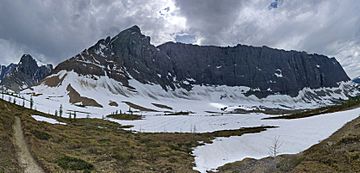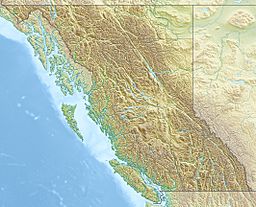Mount Drysdale facts for kids
Quick facts for kids Mount Drysdale |
|
|---|---|

Mount Drysdale (left of center) with the Rockwall (right) as seen from Rockwall Pass
|
|
| Highest point | |
| Elevation | 2,932 m (9,619 ft) |
| Prominence | 162 m (531 ft) |
| Parent peak | Rockwall Peak (2979 m) |
| Listing | Mountains of British Columbia |
| Geography | |
| Location | Kootenay National Park British Columbia, Canada |
| Parent range | Vermilion Range Canadian Rockies |
| Topo map | NTS 82N/01 |
| Geology | |
| Age of rock | Cambrian |
| Type of rock | Ottertail Limestone |
| Climbing | |
| First ascent | John Peck, Dornacilla Peck, (Dornacilla Drysdale), and Dr. Morley Tuttle |
Mount Drysdale is a tall mountain in British Columbia, Canada. It stands 2,932 meters (about 9,620 feet) high. This mountain is found on the western edge of Kootenay National Park. It is part of the Vermilion Range, which is a smaller part of the famous Canadian Rockies.
Mount Drysdale is also part of a huge rock formation called the Rockwall. This Rockwall is a long, steep cliff face. It stretches for many kilometers. The Rockwall Trail is a popular hiking path. It is about 55 kilometers (34 miles) long. Hikers on this trail see amazing views. These include high mountain passes, green meadows, and hanging glaciers. They also see limestone cliffs that can be over 900 meters (3,000 feet) tall.
Mountain History
Mount Drysdale got its name in 1924. It was named by the Geographical Names Board of Canada. This board helps name places in Canada. The mountain honors Charles Wales Drysdale. He was a geologist who studied rocks and land. He worked for the Geological Survey of Canada.
Sadly, Charles Drysdale died on July 10, 1917. He drowned in the Kootenay River. His raft flipped over while he was working. His assistant, William Gray, also drowned. Mount Drysdale and Mount Gray are like two giant pillars. They stand on either side of Wolverine Pass.
The first people to climb Mount Drysdale were John Peck and Dr. Morley Tuttle. They were joined by Dornacilla Peck. She was Charles Drysdale's oldest daughter.
Mountain Rocks
Mount Drysdale is made of a type of rock called Ottertail limestone. Limestone is a sedimentary rock. This means it formed from layers of tiny bits of rock and shells. These layers built up over millions of years. The rocks here formed during the Precambrian to Jurassic periods.
Later, a huge event called the Laramide orogeny happened. This was a time when the Earth's crust moved a lot. It pushed these old rocks eastward. They were even pushed over top of younger rocks. This created the tall mountains we see today.
Mountain Weather
Mount Drysdale has a subarctic climate. This means it has very cold and snowy winters. The summers are usually mild. Temperatures can drop below -20 degrees Celsius (-4 degrees Fahrenheit). With the wind, it can feel even colder, below -30 degrees Celsius (-22 degrees Fahrenheit).
Rain and melting snow from the mountain flow into rivers. Some water drains east into the Vermilion River. Other water flows west into the Beaverfoot River.
Images for kids




